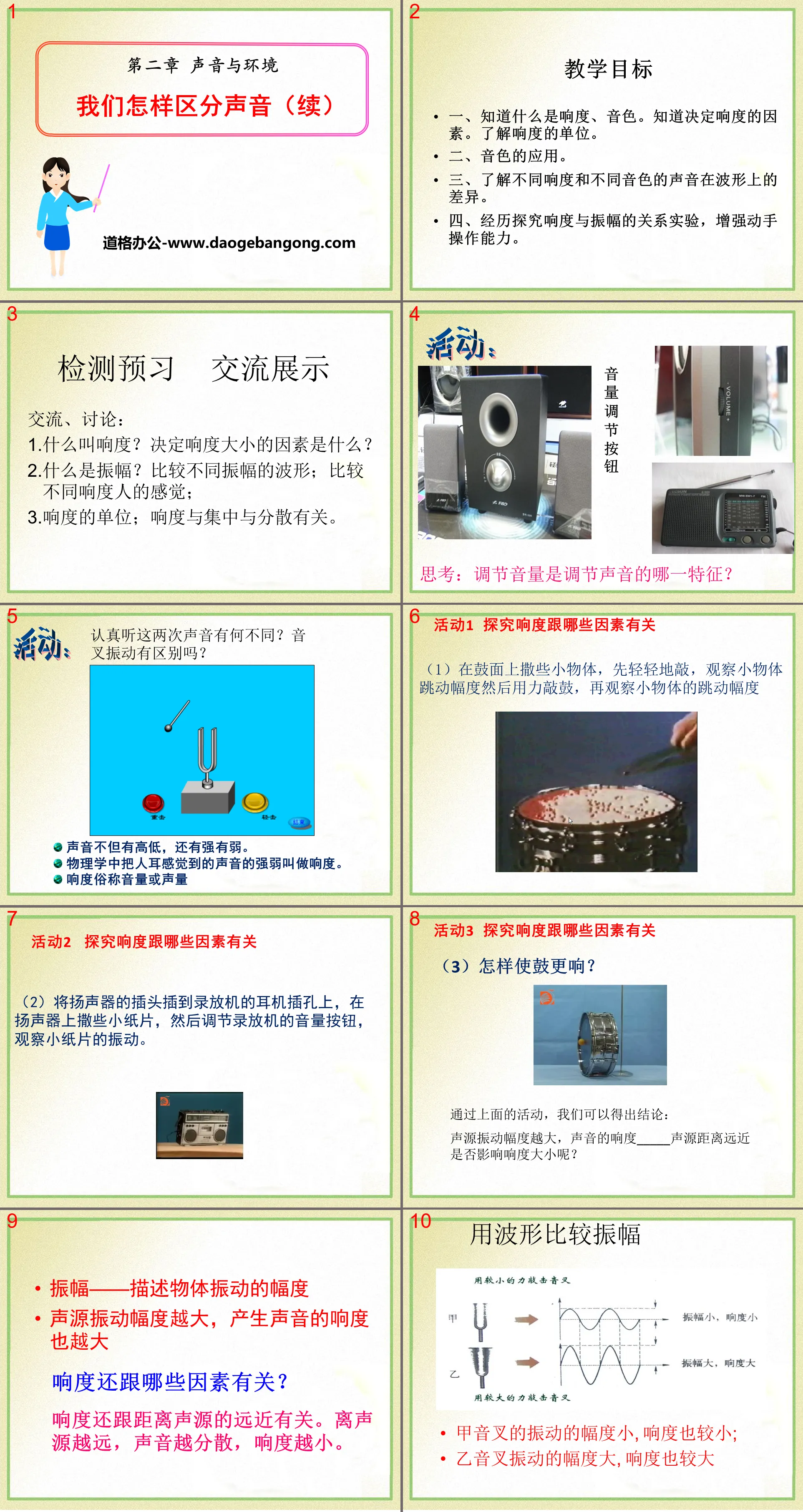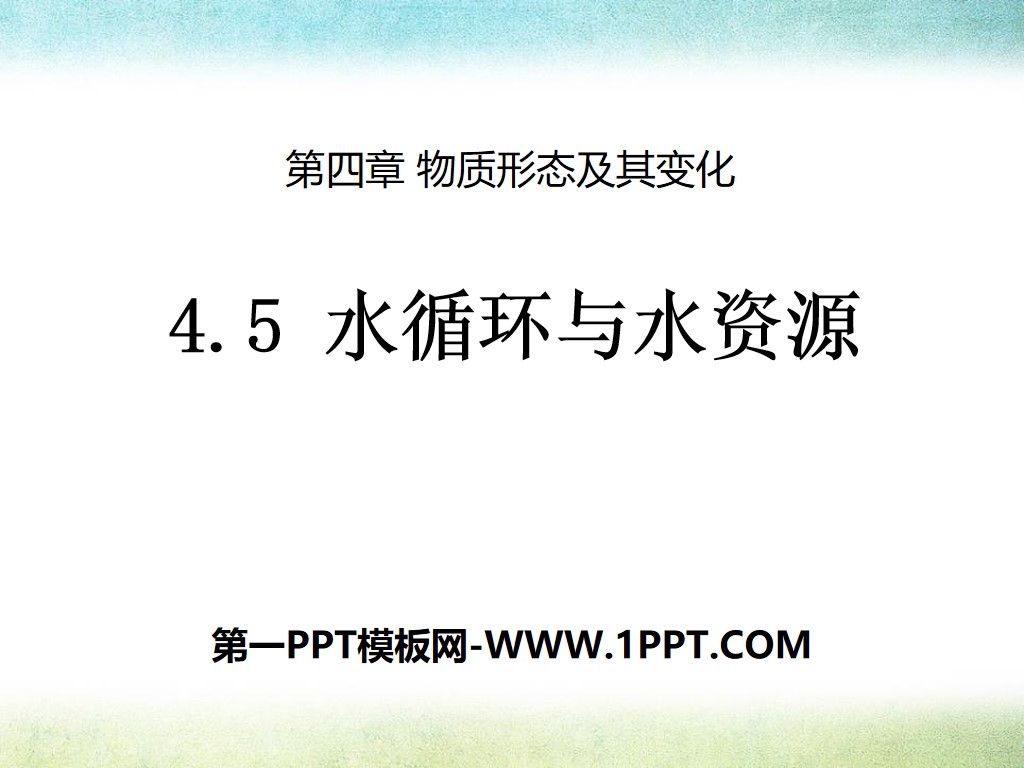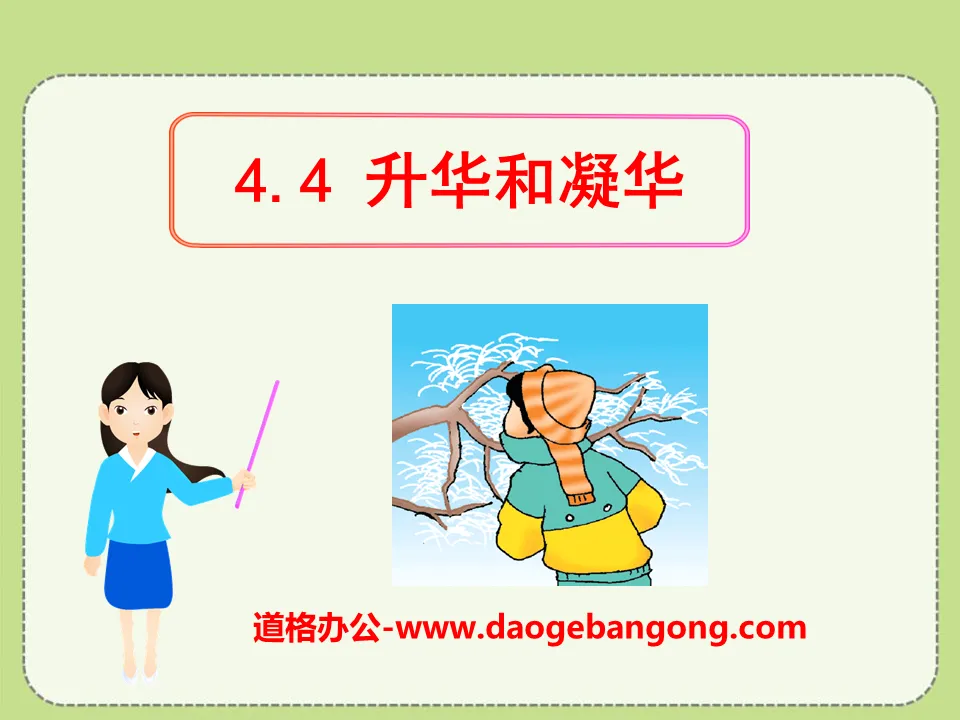
| Category | Format | Size |
|---|---|---|
| Guangdong and Shanghai version of eighth grade physics volume one | pptx | 6 MB |
Description
"How do we distinguish sounds (continued)" Sound and environment PPT courseware 2
teaching objectives
1. Know what loudness and timbre are. Know the factors that determine loudness. Understand the units of loudness.
2. Application of timbre.
3. Understand the differences in waveforms of sounds with different loudness and different timbres.
4. Experience experiments to explore the relationship between loudness and amplitude, and enhance hands-on ability.
Detection Preview Exchange Display
Communication and discussion:
1. What is loudness? What factors determine loudness?
2. What is amplitude? Compare waveforms of different amplitudes; compare people’s feelings of different loudnesses;
3. The unit of loudness; loudness is related to concentration and dispersion.
Activity: Listen carefully to what is the difference between these two sounds? Is there a difference in tuning fork vibration?
Sounds are not only high or low, but also strong or weak.
In physics, the intensity of sound perceived by the human ear is called loudness.
Loudness is commonly known as volume or sound volume
Activity 1 Explore what factors are related to loudness
(1) Sprinkle some small objects on the drum surface, knock it gently first, observe the beating range of the small objects, then hit the drum hard, and then observe the beating range of the small objects.
(2) Insert the speaker plug into the headphone jack of the VCR, sprinkle some small pieces of paper on the speaker, then adjust the volume button of the VCR and observe the vibration of the small paper pieces.
(3) How to make the drum louder?
Through the above activities, we can draw the conclusion:
The greater the vibration amplitude of the sound source, the loudness of the sound _____ Does the distance of the sound source affect the loudness?
Class exercises
1. As shown in the figure below, on the remote control of the TV, there are generally several buttons represented by the following graphics, among which the ones that control the volume (loudness) are ( )
2. Comparing the cry of cows with the cry of mosquitoes, which of the following conclusions is correct ( )
A. The sound of a cow's braying is high-pitched and loud. B. The sound of a cow's braying is low-pitched and low-pitched.
C. The sound of a cow's braying is high-pitched and low-pitched. D. The sound of a cow's braying is low-pitched and loud.
3. Doctors use stethoscopes to diagnose diseases because... ( )
A. A stethoscope can increase the amplitude and loudness of vibrations
B. The stethoscope reduces the dispersion of sound and makes it louder to the human ear.
C. The stethoscope can change the frequency of the sound emitter and make the pitch louder.
D. The stethoscope can shorten the distance between the listener and the sound source, making the vibration amplitude transmitted to the human ear larger.
4. The "high" and "low" in soprano and bass mean that the sound is _____ different, which is mainly determined by the vibration of the sound source _____.
Sound quality – timbre
It turns out that the sounds emitted by different objects have different timbres. It is determined by factors such as the material, structure of the sound body, and the way the sound is produced.
Although the sound emitters have the same pitch and loudness, the human ear can still distinguish them because their timbres are different.
The timbre is determined by the following factors
1. Sound-producing materials
2. The structure of vocalization
3. The way of speaking, etc.
Three characteristics of sound
pitch, loudness, timbre
Characteristics of sound and related factors
Common examples of describing sound characteristics:
1. Description of loudness
Deafening, sounding like a bell, singing loudly, shouting loudly
2. Description of tone
Baritone, soprano, voice as thin as a mosquito and as crisp as a silver bell
3. Description of timbre
Pleasant listening, musical instrument distinction, ventriloquism imitation
Operation:
Classwork: pages 1, 2, 3, and 4 on p38.
Extracurricular homework: basic training, inspection.
Tutorial (preview): a. Briefly introduce the relationship between sound and music; briefly introduce the relationship between sound and architecture; briefly introduce the binaural effect and its application. b. What is noise? What are the hazards? How to control noise? Team leader checks.
Keywords: Sound and environment teaching courseware, how do we distinguish sound teaching courseware, Guangdong and Shanghai version eighth grade physics PPT courseware download, eighth grade physics slide courseware download, sound and environment PPT courseware download, how do we distinguish sound PPT courseware download, .PPT format;
For more information about the PPT courseware "Sound and Environment How Do We Distinguish Sound", please click the Sound and Environment ppt How Do We Distinguish Sound ppt tag.
"How do we distinguish sounds (continued)" Sound and environment PPT courseware:
"How do we distinguish sounds (continued)" PPT courseware on sound and environment 1. Loudness of sounds Sounds are not only high and low, but also strong and weak. In physics, the intensity of sound perceived by the human ear is called loudness. Loudness is commonly known as volume or volume. Activity 1: Explore...
"How Do We Distinguish Sounds" Sound and Environment PPT Courseware 2:
"How Do We Distinguish Sounds" Sound and Environment PPT Courseware 2 Learning Objectives 1. Understand one of the characteristics of sound, pitch 2. Know that the pitch of a sound is related to the vibration frequency of the sound emitter, and know how to adjust the pitch of a stringed instrument 3. Understand the sounds of different pitches The difference in waveform...
"How do we distinguish sounds" Sound and Environment PPT courseware:
"How Do We Distinguish Sounds" Sound and Environment PPT Courseware Teaching Objectives 1. Know the pitch of a sound, and know the factors that determine the pitch. Understand the differences in waveforms of sounds of different pitches. 2. Understand the factors that affect the pitch of stringed instruments. three..
File Info
Update Time: 2024-06-19
This template belongs to Physics courseware Guangdong and Shanghai version of eighth grade physics volume one industry PPT template
"How do we distinguish sounds (continued)" Sound and environment PPT courseware 2 Simple campus recruitment activity planning plan summary enterprise and institution recruitment publicity lecture PPT template is a general PPT template for business post competition provided by the manuscript PPT, simple campus recruitment activity planning plan summary enterprise and institution recruitment promotion Lecture PPT template, you can edit and modify the text and pictures in the source file by downloading the source file. If you want more exquisite business PPT templates, you can come to grid resource. Doug resource PPT, massive PPT template slide material download, we only make high-quality PPT templates!
Tips: If you open the template and feel that it is not suitable for all your needs, you can search for related content "How do we distinguish sounds (continued)" Sound and environment PPT courseware 2 is enough.
How to use the Windows system template
Directly decompress the file and use it with office or wps
How to use the Mac system template
Directly decompress the file and use it Office or wps can be used
Related reading
For more detailed PPT-related tutorials and font tutorials, you can view: Click to see
How to create a high-quality technological sense PPT? 4 ways to share the bottom of the box
Notice
Do not download in WeChat, Zhihu, QQ, built-in browsers, please use mobile browsers to download! If you are a mobile phone user, please download it on your computer!
1. The manuscript PPT is only for study and reference, please delete it 24 hours after downloading.
2. If the resource involves your legitimate rights and interests, delete it immediately.
3. Contact information: service@daogebangong.com
"How do we distinguish sounds (continued)" Sound and environment PPT courseware 2, due to usage restrictions, it is only for personal study and reference use. For commercial use, please go to the relevant official website for authorization.
(Personal non-commercial use refers to the use of this font to complete the display of personal works, including but not limited to the design of personal papers, resumes, etc.)
Preview




















